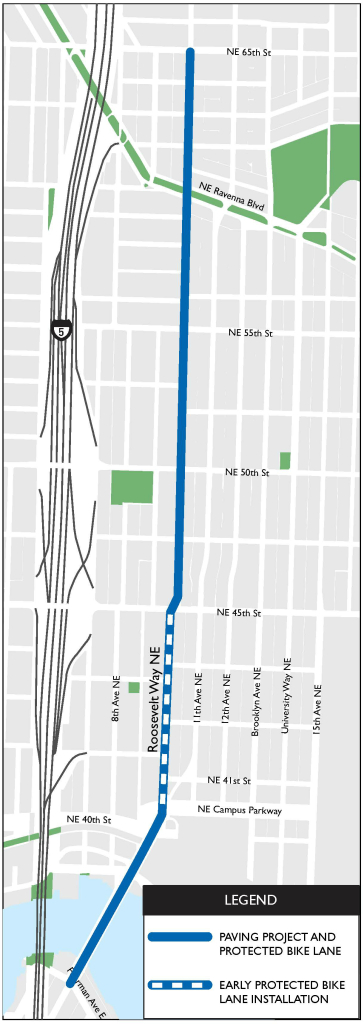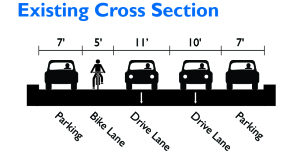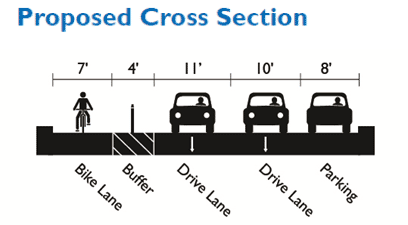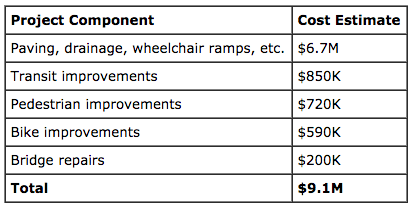SDOT is in the process of a planned repaving project for Roosevelt Way between NE 65th Street (Roosevelt) and Fuhrman Ave E (Eastlake). When we last provided an update on this project, SDOT was focusing much of its effort on repaving, pedestrian and transit enhancements, and modest improvements to bicycle facilities. However, the scope of SDOT’s project has expanded since then. We’d like to recap some of the changes on the way and talk about the big win for cyclists under SDOT’s plan.
Improvements for Bicyclists, Pedestrians, and Transit
 One key element of the project is a one-way protected bike lane (PBL) on the west side of Roosevelt Way. PBLs benefit all users of the right-of-way because they separate bicyclists from general traffic and parked cars, separate pedestrians from potential bicycle conflicts, and provide predictability for drivers when using the street.
One key element of the project is a one-way protected bike lane (PBL) on the west side of Roosevelt Way. PBLs benefit all users of the right-of-way because they separate bicyclists from general traffic and parked cars, separate pedestrians from potential bicycle conflicts, and provide predictability for drivers when using the street.
Originally, SDOT had only planned a new PBL facility between NE 45th Street and the University Bridge due to funding constraints. SDOT had expressed a hope that more improvements could be added along the corridor in the spirit of the City’s Complete Streets Ordinance and Bicycle Master Plan if further funding could be found. Yesterday, the agency announced that it had indeed secured the necessary funding to construct the PBL along the whole length of the Roosevelt Way Repaving project. The PBL will now stretch from NE 65th Street to Fuhrman Ave E providing up to 25 more blocks of safe biking infrastructure.
The case for extending the Roosevelt Way PBL was strong from the outset of the project. Between October 2010 and October 2014, bicyclists had been involved in 21 separate collision along the full Roosevelt Way corridor with 9 of those on the blocks between NE 65th St and NE 45th St.
The first portion of the PBL between NE 45th St and the University Bridge should launch before the larger project, slated for sometime in early 2015. The PBL will ultimately be integrated into the new University Neighborhood Greenway (12th Ave NE) via NE 47th St and the Ravenna Blvd buffered bike lane–which will also soon be upgraded to a PBL. Where the PBL crosses in front of driveways, SDOT will apply green advisory paint to the asphalt to indicate the sensitive nature of such crossings.
Aside from the PBL, SDOT will enhance the experience for pedestrians and transit users alike along Roosevelt Way. The agency plans to reconstruct or repair sidewalks where warranted, add curb bulbs at the ends of blocks, and provide new ADA-compliant ramps. New curb bulbs will be especially welcome because they reduce the distance that pedestrians must walk to cross the street while constricting the movement of motorized vehicles. Together, this creates a safer situation for all users.
Transit will get a good boost from the project through the deployment of “transit islands” adjacent to existing bus stops along Roosevelt Way (much like those seen on Dexter Ave N). These transit stops are in-lane stops that are separated from the sidewalk. This separation is typically small, but enough to enable bicyclists to pass behind the transit island unobstructed. This particular feature is a smart way to add safety for bicyclists because it removes the need to play leapfrog with buses under the common bike lane arrangement. Meanwhile, buses can directly stop adjacent to the transit islands instead of pulling over to the side of the street. This enhances the reliability of buses because operators no longer have to re-enter traffic, which can add delay to buses and increase potential traffic conflicts. For transit riders, transit islands will increase waiting space at stops and provide level-boarding for ADA users.
What Changes Could Look Like
So you may be wondering what these changes mean for Roosevelt Way. SDOT plans to retain the two travel lanes along Roosevelt Way. However, in order to provide the needed pedestrian, bicycle, and transit improvements, parking and loading zones will be removed along the west side of the street. The agency will be conducting a utilization analysis to determine any potential impacts to businesses and residents that may result from parking removal. (But, as we’ve noted in the past, the data usually shows positive results when parking is removed or managed.) Below, you can see can a comparison between the current street layout and the revised layout under SDOT’s plan.
  |
Cost and Timing
The total cost of the Roosevelt Way improvement projects will come in at around $9.1 million with funding from the voter-approved Bridging the Gap Levy. While repaving of Roosevelt Way won’t take place until Spring 2015, initial work on the lower portion of the PBL should begin in early 2015. SDOT anticipates that full project work on Roosevelt Way should wrap up sometime in Spring 2016.

How To Get Involved
SDOT will hold three meetings later this month to listen to the public and answer questions about the project. The times and locations for these meetings are as follows:
Tuesday, January 20
2pm to 3.30pm
University Heights Community Center
5031 University Way NE
Wednesday, January 21
8am to 9.30am
Wayward Coffeehouse
6417 Roosevelt Way NE
Thursday, January 22
5.30pm to 7pm
University Heights Community Center
5031 University Way NE
If you have comments or questions about the projects, you can contact Paul Elliott. For more details about the Roosevelt protected bike lane and repaving projects, check out SDOT’s PBL Q&A and repaving information pages.
Stephen is a professional urban planner in Puget Sound with a passion for sustainable, livable, and diverse cities. He is especially interested in how policies, regulations, and programs can promote positive outcomes for communities. With stints in great cities like Bellingham and Cork, Stephen currently lives in Seattle. He primarily covers land use and transportation issues and has been with The Urbanist since 2014.


